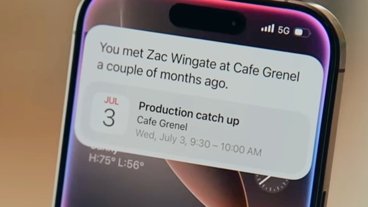A future version of the Apple Vision Pro could end up with Tandem Mini OLED displays, a display panel stacking technique used on the M4 iPad Pro.
Apple's introduction of the M4 iPad Pro brought with it many changes, but one of the biggest is the updated display tech. Rather than mini-LED backlighting, Apple instead switched to a display system called Tandem OLED.
Now, it appears that Samsung and LG Display are working to make Tandem OLED work on micro OLED panels, in a Wednesday report from SisaJournal. The aim is to increase the technology gap between the two firms and rival outfits in China.
Tandem OLED is literally the use of two layers of OLED layers, with the stacking providing increased brightness and improvements to power usage. What Samsung and LG want to do is to apply the technique to Micro OLED displays.
As the name hints, Micro OLED displays are produced with extremely small pixels, with the pixel density soaring to the thousands of pixels per inch. This is the resolution level used by companies like Apple to produce displays for the Apple Vision Pro, which requires high resolutions in a tiny display.
Micro OLED uses a silicon substrate instead of glass to improve the resolution, but it doesn't necessarily help with brightness. Using the Tandem OLED technique with Micro LED should result in a much brighter display.
As for when we can expect Samsung and LG to introduce Tandem Mini OLED displays, the report says it will depend on when the companies invest to commercialize it.
LG apparently has an advantage in Tandem OLED, having used it for automotive products, as well as for the OLED iPad Pro models. Samsung Display is also mass producing Tandem OLED panels for Apple, and has gradually taken up more share in iPad Pro display shipments.
As for the current-gen Apple Vision Pro, the Micro OLED displays are supplied by Sony. Timetables on when this will happen are not clear, but are likely measured in years, if ever.
 Malcolm Owen
Malcolm Owen







-m.jpg)






 Chip Loder
Chip Loder
 Mike Wuerthele
Mike Wuerthele


 Amber Neely
Amber Neely
 William Gallagher
William Gallagher




-m.jpg)






7 Comments
How bright do you need a display to be when it is sitting right in front of your eye?
Despite the overall high quality of the panels being currently use, the AVP needs a lot more resolution TBH; the pixels per degree is way too low for clear text at smaller sizes. At least my experience in two separate demos. Its fine for gaming or media consumption, but will need that resolution to make deep forays into productivity use in many areas.
We begin to see some of the differentiation between Pro and a lower cost Vision version. Lower cost version will use current LED Panels. Vision Pro 2 will use these new OLED panels.